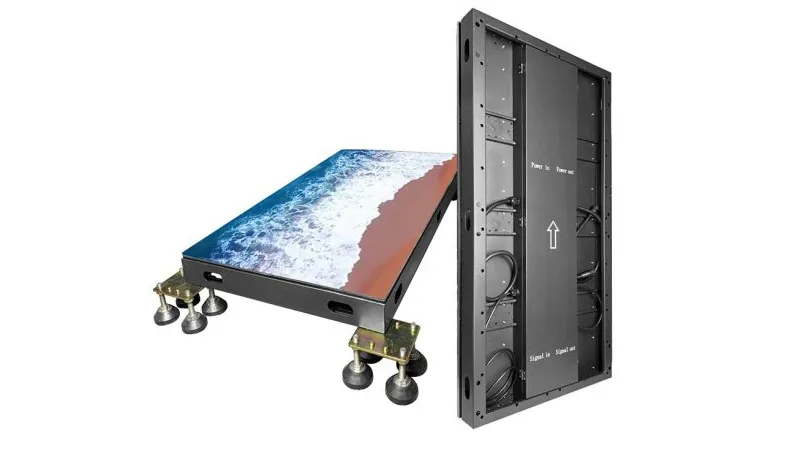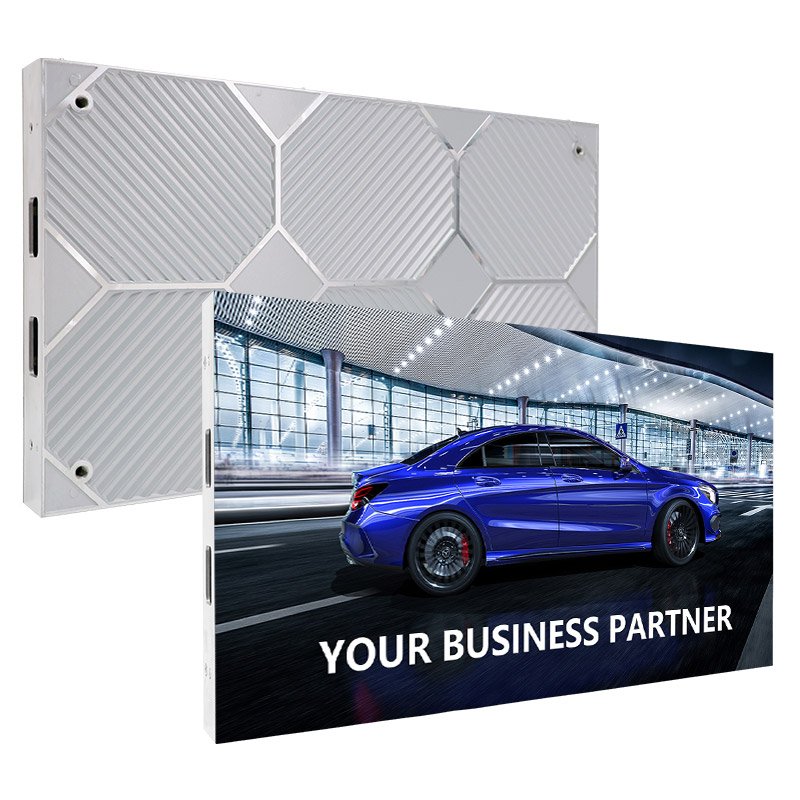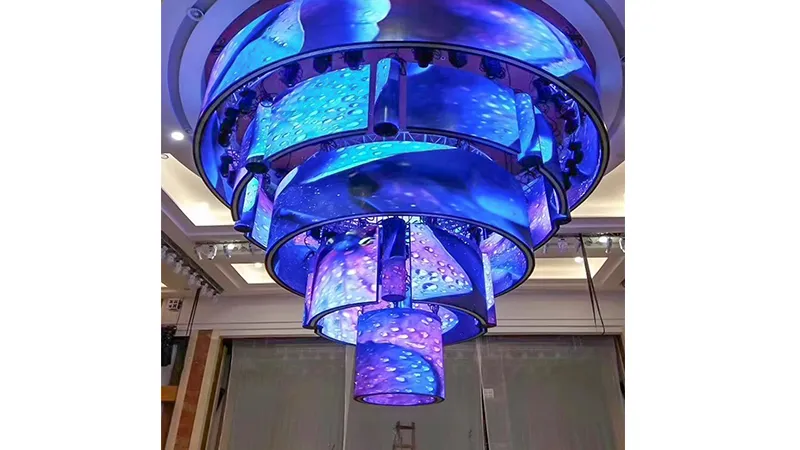Virtual Production LED Wall Recommendation
LED virtual production displays are a revolutionary filmmaking technology that utilizes high-resolution LED panels to render virtual environments in real time, enabling instant compositing of captured footage and authentic physical light interaction.
2025 New LED Screen Price for You
The World’s Biggest Virtual Production LED Screen
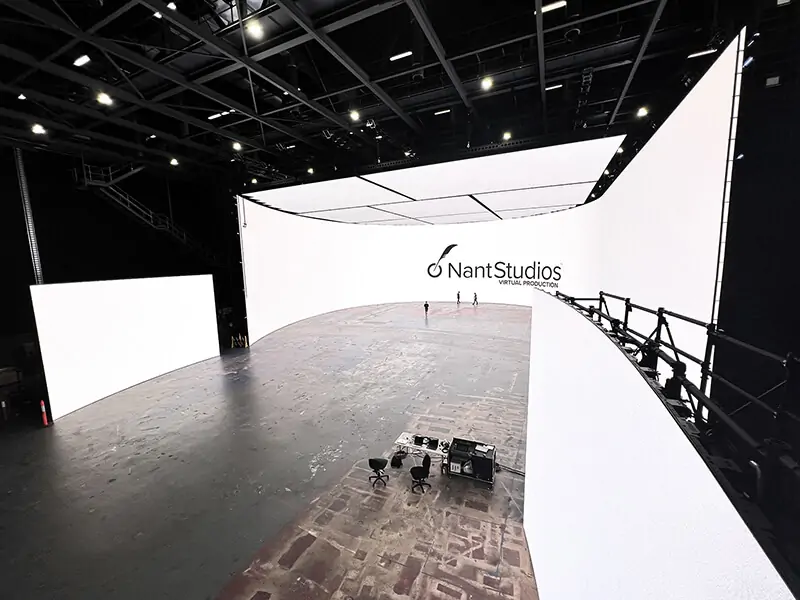
NantStudios Virtual Production Stages
NantStudios Stage features the world’s largest LED volume, spanning a massive 101 ft wide × 124 ft long × 39 ft high on a 25,000 sq ft stage. The system includes a water tank measuring 12 x28 x3 m and two LED articulating sections that are controlled by 3D software to create dynamic lighting.The facility has been fully soundproofed and climate-controlled to support complex productions as well as in-camera VFX effects on a large scale.
Vancouver LED Volume
Recognized by Guinness World Records as the largest LED volume stage globally, this expansive facility spans 22,000 sq ft, comprising 2,500 wall panels and 760 ceiling panels . Designed for high-end studio projects—such as Netflix’s Avatar: The Last Airbender—it delivers full 360° LED coverage, powered by Unreal Engine, enabling immersive storytelling and in-camera realism for major feature and series productions
EagerLED Related LED Volume Wall Videos
Why Choose EagerLED
2025 New LED Screen Price for You
2025 Virtual Production LED Wall: Price and Brand Guide!
2025 Virtual Production LED Wall: Price and Brand Guide!
Virtual production LED walls are revolutionizing traditional filmmaking with advanced capabilities for unprecedented visual fidelity. Whether you’re planning your first prototype or scaling a studio, this buyer’s guide offers cost analyses, practical comparison insights, technical checklists, and best setup tips to make informed decisions.
Table of Contents
- 1. Ի՞նչ է վիրտուալ արտադրական LED պատը։
- 2. Ինչպե՞ս է աշխատում LED ծավալային պատը։
- 3. Վիրտուալ արտադրության LED պատերի կիրառությունները
- 4. LED ձայնի պատն ընդդեմ կանաչ էկրանի
- 5. Վիրտուալ արտադրության LED պատի գների ուղեցույց
- 6. Ինչպե՞ս ընտրել լավագույն վիրտուալ արտադրության LED պատը։
- 7. Ինչպե՞ս կառուցել LED պատ վիրտուալ արտադրության համար։
- 8. ՀՏՀ
- 9: եզրափակում
1. What is a Virtual Production LED Wall?
It seems to me that some people who do not participate in any film production ever before will feel confused about this term – virtual production.
1.1 What Does Virtual Production Mean?
Virtual production is a method of film production that uses computer-generated images (CGI), augmented reality, motion tracking, and other technologies to create realistic backdrops and effects on a virtual set.
With VP, visual effects are not applied to a scene only post-production. They are now working and iterating on the overall whole pre-production.
Virtual production allows filmmakers the freedom to create various vast landscapes, sweeping vistas, and realistic creatures through imagination. Therefore, it is widely used in both animated and live-action projects.
1.2 What is a Virtual Production LED Wall?
The Virtual Production LED Wall (also known as the LED Volume Wall) is a high-resolution display system consisting of modular panels that are assembled into large, curved or tilted structures to create dynamic virtual backdrops in film production setups.
Its function is to display real-time computer-generated images in place of traditional green screens, providing realistic lighting, reflections, and environmental integration for live-action scenes, as well as parallax-accurate visual effects through synchronized camera tracking.
These LED volume walls are optimized for immersive experiences and visual narratives to support a seamless on-set workflow that significantly reduces post-production costs.
2. How Does LED Volume Wall Work?
The virtual production LED screen works by combining several advanced technologies – display technology, precise synchronization, real-time rendering, and integrated lighting, to create immersive virtual environments.
LED Modules: The virtue production LED wall is composed of high-resolution LED modules with fine pixel pitches to display crisp and dynamic backdrops for film production.
Camera Tracking System: In order to adjust the virtue background rightly, virtual production LED wall has built-in infrared sensors or encoders to capture camera position, tilt, and focal length data.
Game Engine Rendering: Rendering engine like unreal engine generates photorealistic environments in real-time based on camera data, rendering images with accurate parallax.
Display Synchronization: Genlock technology syncs the LED refresh rate (≥7,680Hz) with the camera shutter to eliminate flicker during filming.
Integrated Lighting: Unlike traditional green screens, the LED volume wall provides accurate, live illumination and reflections on actors and props without the need for manual adjustment.
Optical Calibration: Colorimetry ensures precise color matching between skins (Delta E < 1) for seamless visual continuity throughout the volume.
Parallax Effect: The background naturally changes perspective as the camera moves, creating a realistic depth perception with real-time 3D scene adjustments.
3. Applications of Virtual Production LED Walls
In addition to film production, where can virtual production LED walls be used? Here is the breakdown of using scenarios for LED volume walls.
3.1 News Studio and Live Streaming Platform
The news studio and live streaming platform utilize virtual production LED screens to create dynamic virtual backdrops that allow presenters to broadcast from ‘on location’ scenarios, such as an Olympic stadium or a disaster site, to enhance audience immersion.
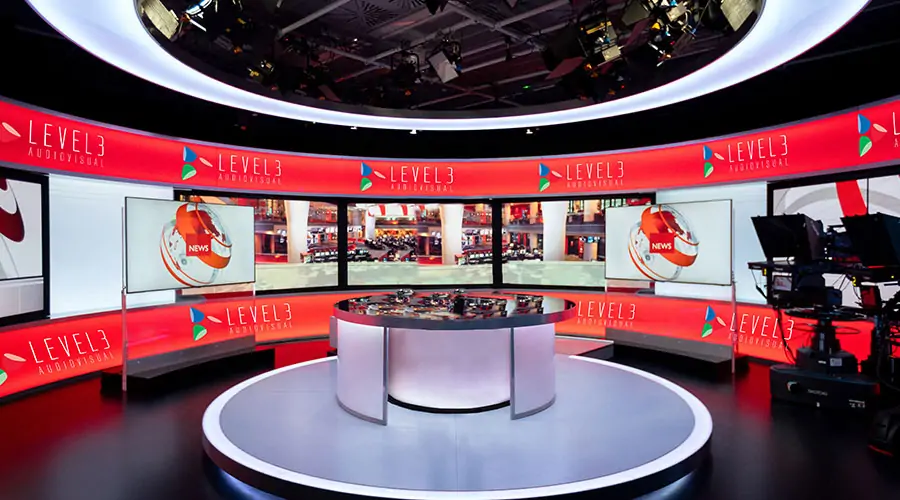
3.2 Industrial Design & Visualization
In automotive, aerospace and other fields, LED Volume Wall is used for product prototype visualization and design. Engineers can simulate the performance of products in different light and climate in the virtual environment, and adjust the design parameters in real-time.

3.3 Product Launches & Corporate Events
For brand launches or corporate presentations, virtual production LED walls provide an impactful backdrop that delivers high production value. Flexible and remotely updatable, they eliminate the need for complex physical setups or location scouting.
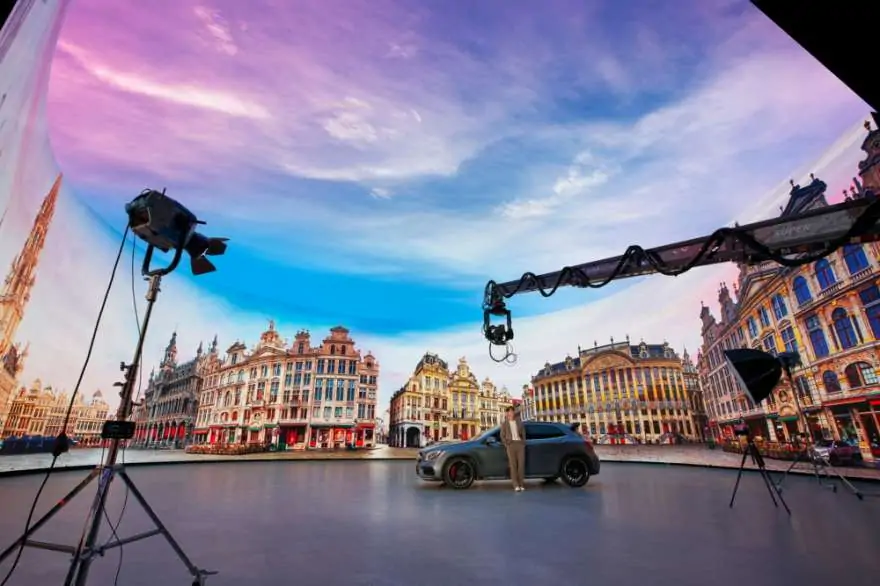
3.4 Concert Stage
With LED technology continually updating, stage designers started to adopt LED volume walls to create a special film-like visual effect. Combined with post-production technology, this dynamic visual effect can come to life on stage with a giant virtual production LED wall to provide audiences with an immersive and storytelling stage performance.
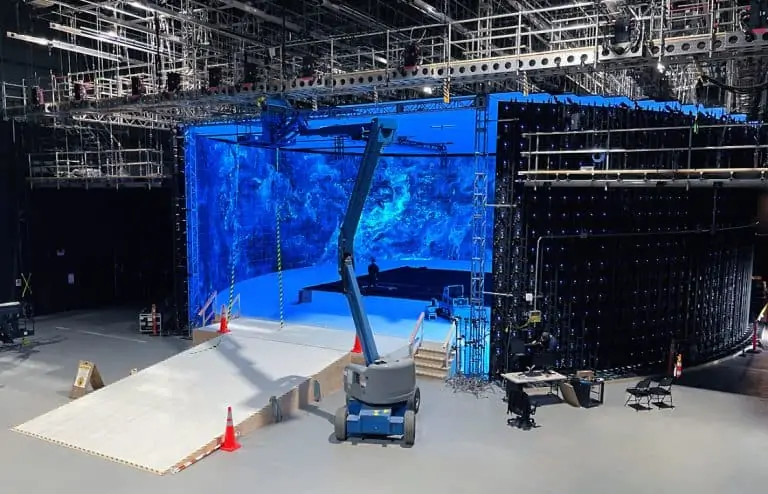
3.5 Real Estate Industry
The LED virtual production is used to build virtual showrooms, which allows customers to view different house types, decoration styles and surrounding landscapes in 360° without the need for a physical building, and significantly reduces the developer’s display costs.
Through real-time rendering technology, the same space can simulate day or night and seasonal changes to enhance the sense of immersion of customers.
3.6 Interactive Education
In modern classrooms, virtue production LED walls provide hybrid learning methods for students. They can virtually “enter” historical events or manipulate 3D scientific models via touch or gesture controls. It significantly strengthens interaction between teachers and students and enhances learning effects.
4. LED Volume Wall VS Green Screen
In my view, for choosing virtual production LED walls or green screens, there are still many filmmakers are hesitate and don’t exactly know which one is better. Now, we will delve into their main differences and cost gaps.
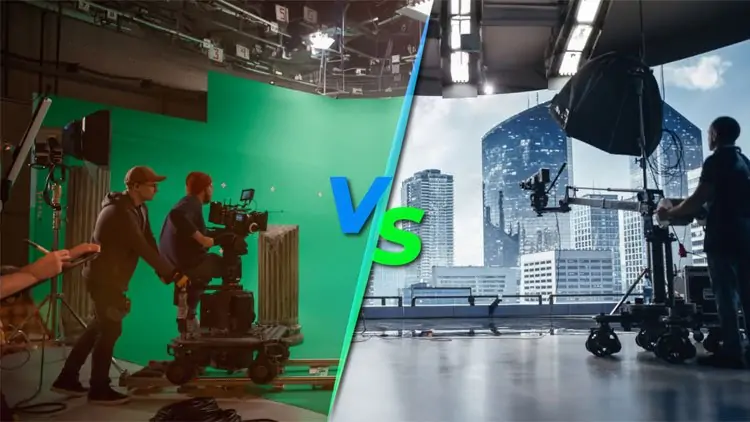
4.1 LED Volume Walls Pros
1. Time Visuals: Virtual production LED walls create realistic and dynamic backgrounds using advanced 3D game engines, such as Unreal Engine. The virtual environment can be viewed and interacted with by actors and directors in real-time on the set, which enhances the realism and engagement of the scene.
2. Natural Lighting: The LED virtual production can serve as an onset lighting source to supply consistent lighting and natural ambient illumination, ensuring seamless environmental integration.
3. Realistic Reflections: The LED walls for virtual production deliver true-to-life reflections on set, improving realism, performance, and visual consistency—while minimizing post-production labor and improving immersion.
4. Streamlined Workflow: Teams adopt a 3D game engine to pre-build and visualize entire scenes before filming, turning complex virtual production into real-time on-set filmmaking. It greatly reduces the cost of post-production, CGI, and VFX.
5. Flexible Switching: Virtual production LED screens allow you to freely change the backdrop in real-time according to various shooting requirements, which significantly shortens the time of scene preparation.
4.2 LED Volume Walls Cons
1. High Initial Investment:The LED walls for virtual production require high upfront costs in complex hardware components, advanced supporting systems, skilled technicians, infrastructure requirements, and content production.
2. Technical Complexity: Virtual production LED screen combines a real-time game engine, high-resolution LED skinning, camera tracking, genlock, color calibration and rendering pipeline into a single production environment. Therefore, it needs a technical expertise specializing in controlling, installing, using, and maintaining this giant screen.
3. Pre-Production: When filming on an LED wall, all VFX must be pre-produced and completed prior to shooting to achieve perfect film effects. It adds significant pressure and complexity in the pre-production stage.
4. Shadow Issues: Natural shadows increase credibility in a virtual setting. But it is impossible for LED volume walls to create realistic shadows even if you installed an LED floor display on the ground.
5. Synchronization Complexity: The LED wall for virtual production can only render one camera view at a time. Switching from one camera to another can cause a 5-6 frame delay, resulting in a noticeable ‘background flicker’when the wall is updated.
4.3 Green Screen Pros
1. Cost-Effective: Affordable and easy to set up, green screens are ideal for flexible or infrequent workflows. Ideal for various locations or stages requiring extensive backdrops.
2. Unlimited Creative Potential: Editors have the freedom to insert any imaginable or animated background, enabling diverse storytelling without needing on-location shoots.
3. Controlled Shooting Environment: Use the green screen to have complete control over the shooting environment, eliminating distractions such as weather, lighting changes, and ambient noise.
4. Minimal Technical Barriers: No need for camera tracking, render farms, or specialized engineers. The standard crews can operate and control them.
4.4 Green Screen Cons
1. Green Spill: Green screens reflect color onto subjects (spill), especially under high luminance, complicating keying and lighting setups.
2. Actor Performance Limitation: Without an actual set, actors must use their imaginations to imagine their surroundings, which may impede authenticity and interaction when performing on camera.
3. Camera Movement Restrictions: Complex camera moves can result in keying issues like motion blur or perspective mismatch, decreasing production flexibility.
4. Complex Post-Production: Green screen post-production can often become complex and time consuming when dealing with uneven lighting, motion blurring, color spill, and fine details.
4.5 LED Volume Walls VS Green Screens: Cost Breakdown
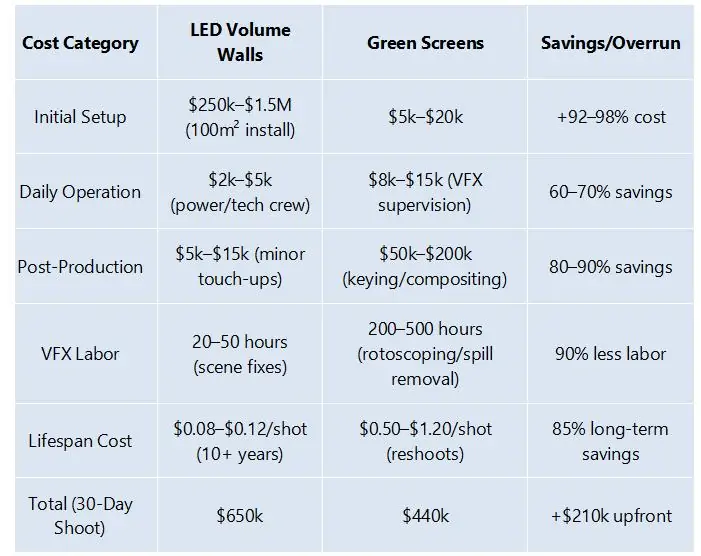
Key Insight:
- Green Screens win on initial costs but lose on the cost of VFX labor, post-production, and reshoot, etc.
- Virtual production LED walls require higher upfront costs but low costs in daily operation, post-production, VFX labor, and lifespan.
5. Virtual Production LED Wall Price Guide
Here’s a comprehensive price guide of Virtual Production LED Walls in 2025.
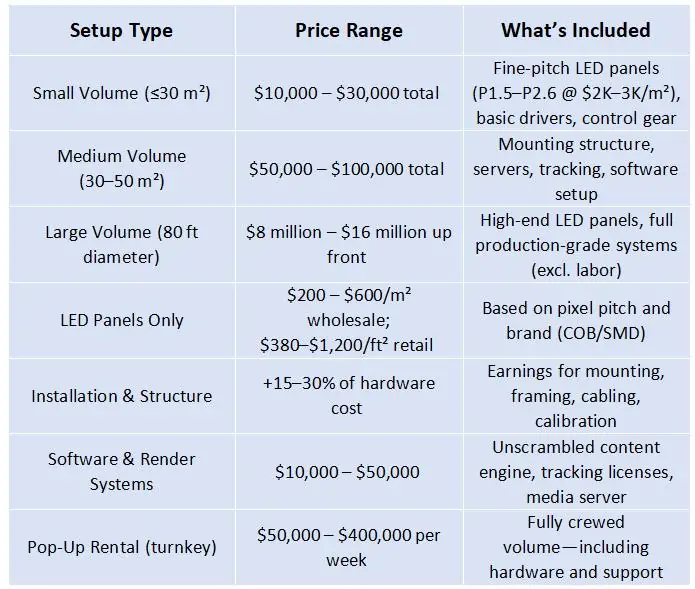
Key Cost Alert:
- Pixel Pitch and Resolution: Small Pitch (P1.5-P2.6) costs about $2,000-$3,000 /m²; Medium Pitch P2.5-P5 costs rise to $600-$1,800 /m²; Outdoor Pitch P6+ costs $300-$900 /m² .
- Panel Technology and Brand Premiums: COB panel prices are up 18-22%; High-end brands are about 15-25% above average.
- Installation Complexity: $700-$2,500/m²cost increase for curved or outdoor installation; Straight mounts are $200–500/m² .
- High-Performance Features: Intelligent brightness saves 30% in energy; High refresh rate of 7,680Hz adds $25/ft².
Recommendation:
- Small Studios: Small volume walls(≤20 m²) are an ideal choice for short-term or low-scale projects. You can also consider to rent a virtual production LED wall for shootings.
- Mid-Scale Studios: Choose the LED volume with 30–50 m²at $50–100K.
- Full-Scale Stages: You can customize the virtual production LED screen according to actual stage sizes and special shooting demands.
6. How to Choose the Best Virtual Production LED Wall?
If you want to choose the best LED wall for virtual production, you should balance technical specs, creative needs, and budget limitations. Here is a step-by-step guide to help you consider all key factors when selecting a virtual production LED wall.
(1) Scan Rate: Film-level production(1:16); Episode/commercial production(1:24-1:32); Short videos/educational videos (1:32)
(2) Pixel Pitch: The optimal choice for virtual production LED walls is P2.3-P2.6. They require a lower pixel pitch for better detail capture.
(3) Brightness: 1000-1500nits brightness is a vital element for LED volume walls to completely display the self-luminous object.
(4) Viewing Angle: The viewing angle of LED walls for virtual production is preferably 160°or above, which effectively enhances the range of camera movement.
(5) Refresh Rate: 3840Hz refresh rates can satisfy the majority of shooting requirements. If the refresh rate is as high as 7640Hz, the frames per second (FPS) would be about 60.
(6) Color Accuracy: Make sure your virtual production LED walls are producing accurate colors. Color gamut must be Rec.2020 or DCI-P3 and support BT.709/BT.2020.
(7) Grayscale: The LED virtual production has built-in MBI5262, MBI5264, MBI5265 LED driver chips, which can offer 16bit grayscale.
(8) Hardware Compatibility: Integrate your virtual production LED wall with compatible processors (Brompton, Novastar, etc.), media servers, real-time engines, and camera tracking. Confirm support for genlock, firmware consistency, and expert technical service from your manufacturer.
5 Must-Check Technical Points When Buying a Virtual Production LED Screen?
- Pixel Pitch
- Refresh Rate
- Brightness
- Viewing Angle
- Hardware Compatibility
In addition to these factors above, you should take full account of the qualification and experience of LED volume wall suppliers, ensuring that they provide professional customized service, product warranty, and after-sales support.
7. How to Build an LED Wall for Virtual Production?
Before starting to build your LED wall for virtual production, you should first ascertain your wall dimensions, specifications, mountings as well as electrical setups. That’s the premise that you can install it successfully.
7.1 Groundwork before Building
7.1.1 Choose the Right Size of Your LED Volume
When selecting a virtual production LED wall size, prioritize your project types and available space. For interviews, smaller volumes (20-30ft) suffice, while complex scenes (e.g., car chases) require 50ft+. Versatile semicircular setups (30-50ft) balance flexibility and space efficiency.
7.1.2 Consider Your Mounting Ways
When selecting an LED volume mounting method, ground support is cost-efficient but requires 3-4 feet of rear space for rigging and maintenance, while ceiling mounting minimizes seams but demands certified load-bearing points and higher budgets. You can choose one according to your actual condition.
7.1.3 Figure out Your Electrical Setup
Unsurprisingly, adequate power provisioning is critical for LED walls, requiring calculations based on wall size, tile quantity/type, and acknowledging operational brightness typically at 10-20% nits rather than maximum output.
Prioritize safety margins like allocating 5-6 tiles per 20A breaker, utilizing distribution boxes for large installations (100-150+ tiles), and ensuring permanent outlets behind the wall comply strictly with local electrical codes for spacing and safety.
7.2 How to Setup LED Volume Walls?
a. Mount Supports Preparation: Precision leveling of adjustable base bars is critical, as even 1mm deviations can compound into structural instability and diode damage during tile stacking. Laser or carpentry levels ensure foundational accuracy.
b. Uniform Tile Stacking: Tiles must be placed right-to-left per row, locking into base bars and adjacent units to maintain seamless alignment. Cumulative misalignments risk visible seams and hardware damage.
c. Reinforce Your Stacking Structure: During tile installation, simultaneously construct rear base trusses – installing them on every alternate column while adding rear connectors at every second or third row to secure tiles to the stacking bar.
d. Ground Support Counterweight: Counterweights (typically sandbags or similar weights) are critical for stabilizing ground-supported LED volumes, preventing leaning or collapse (Except ceiling mounting and wall mounting).
e. Data Cabling Strategy: Data cables are daisy-chained, with each output serving a fixed number of LEDs. The bit rate (and thus signal fidelity) depends on the LED count per chain—fewer tiles per chain improve fidelity but require more processor capacity to handle additional chains.
f. Power Cabling Strategy: Power chain capacity depends directly on your supply’s limits. Ideally, dedicate individual 20A breakers per tile column to prevent overloads. For larger LED volume walls, distribution boxes are essential.
8. FAQs
9. Conclusion
In summary, LED volume walls and green screens each offer distinct benefits based on your creative goals, budget, and production scale. LED volumes deliver immersive lighting, real-time feedback, and efficiency, while green screens provide flexibility and lower upfront costs. This purchasing and setup guidance will help your studio choose the best virtual production solution. Contact EagerLED to get more information!

